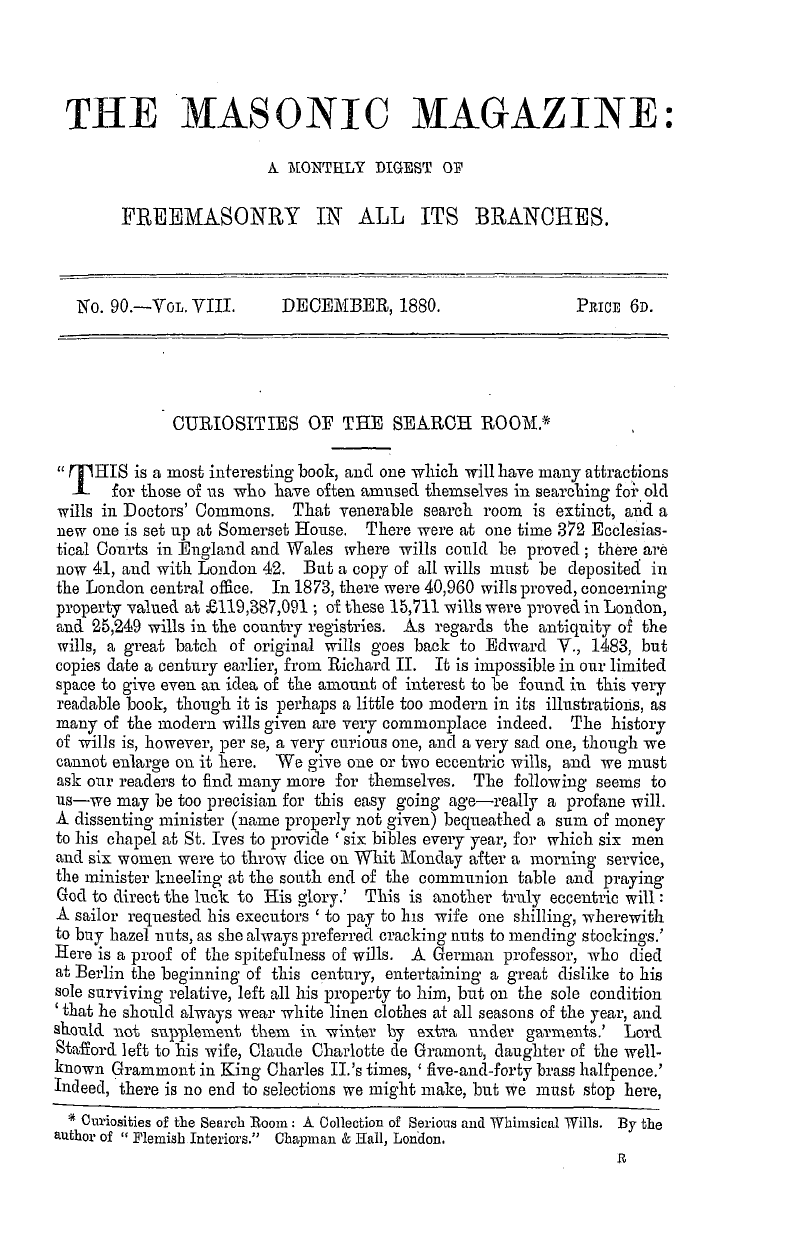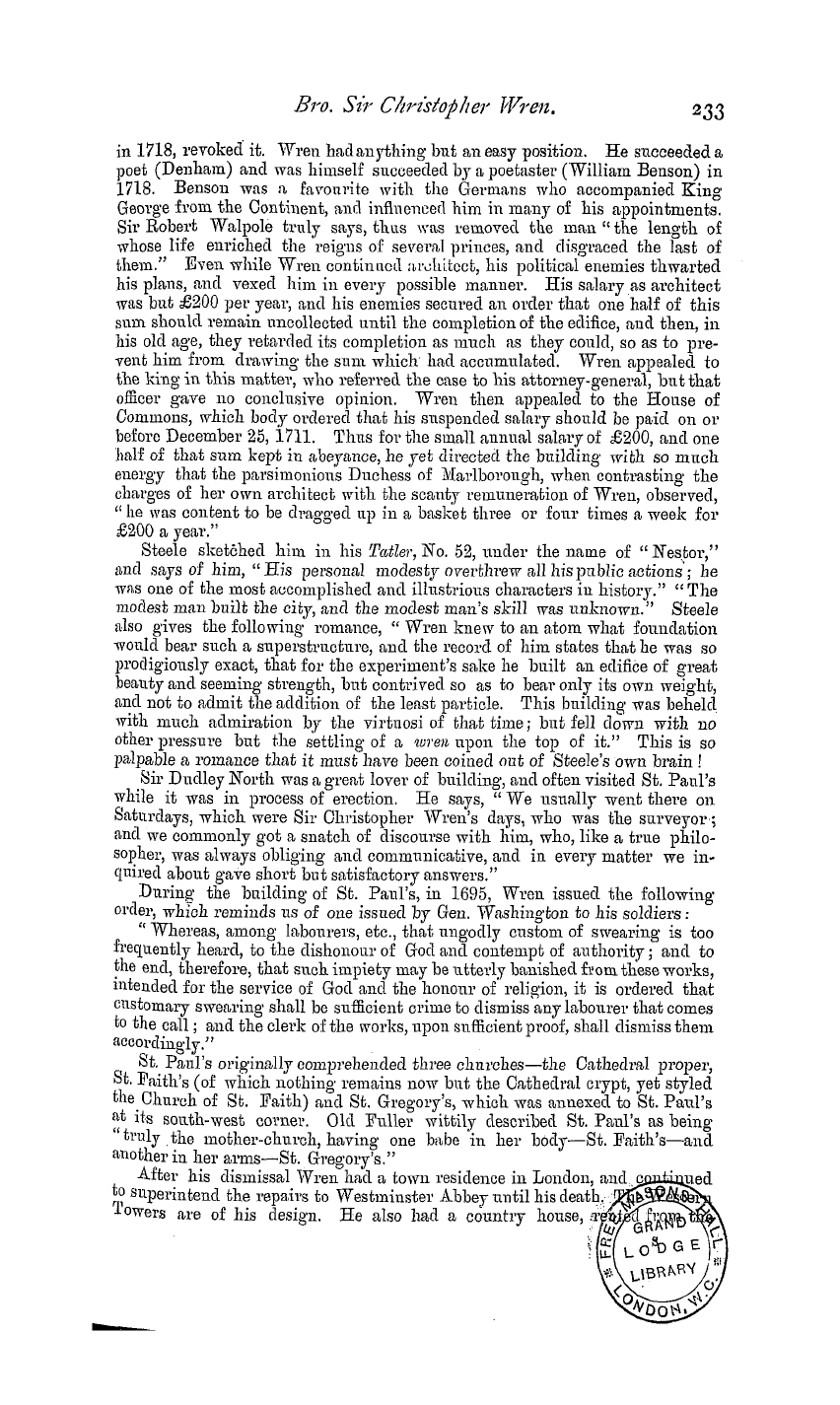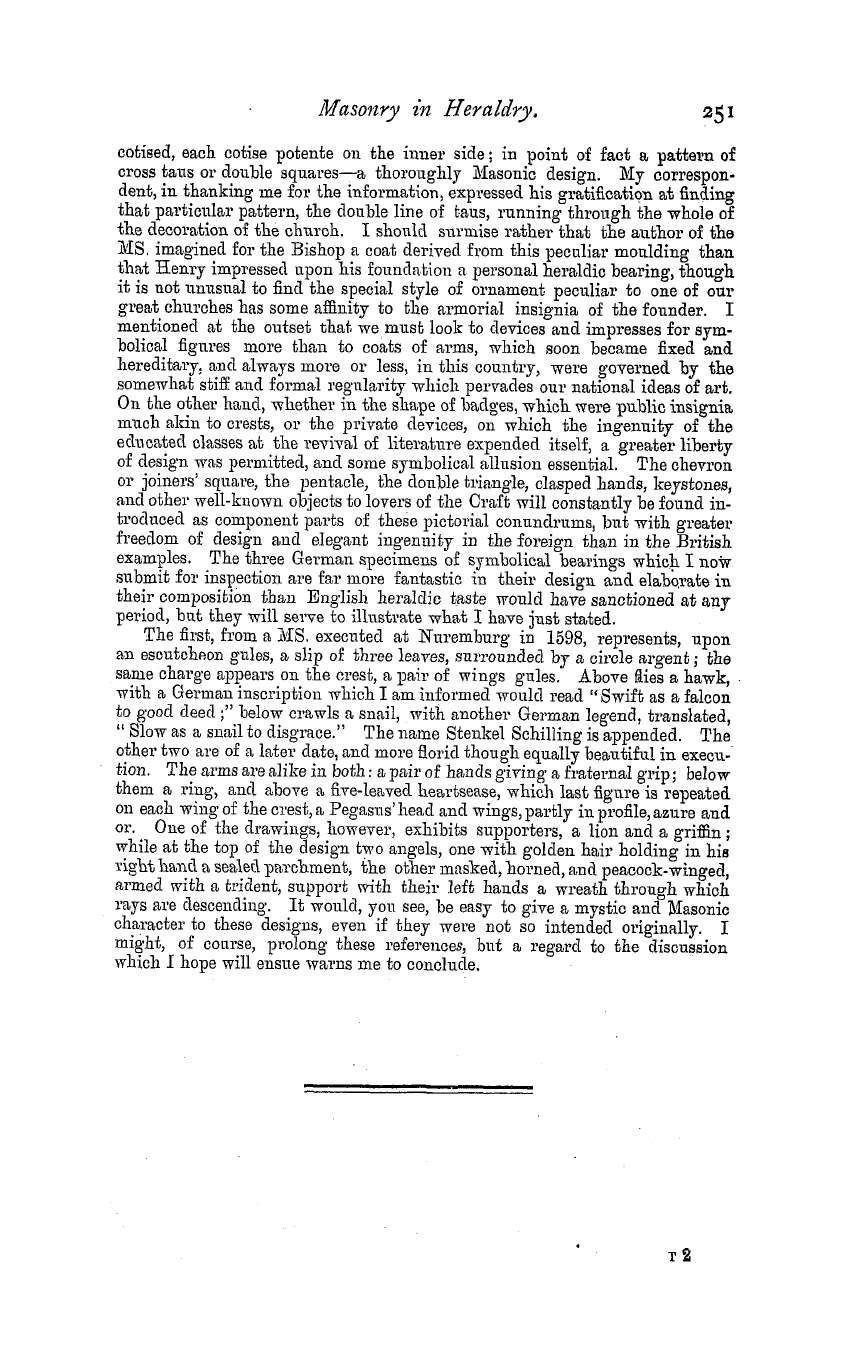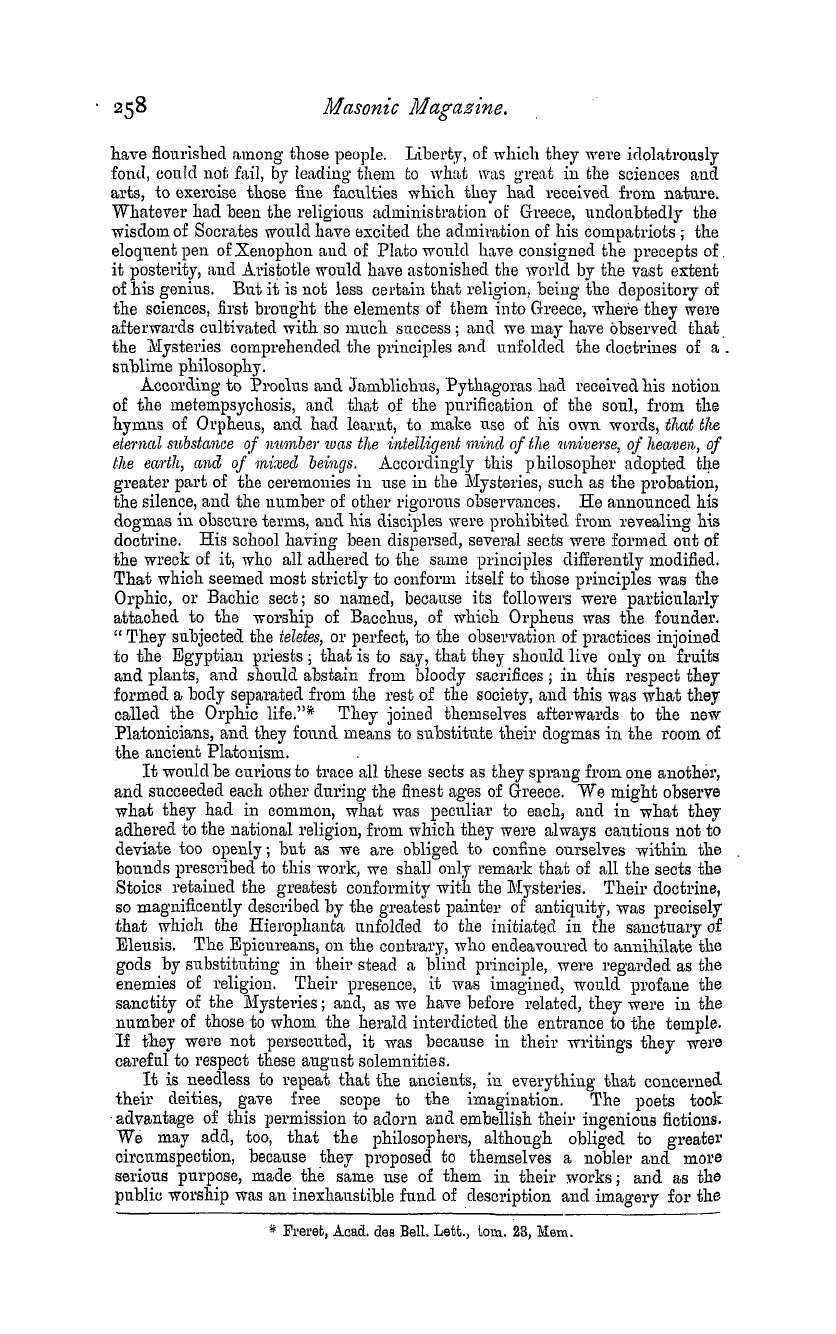-
Articles/Ads
Article MASONRY IN HERALDRY. Page 1 of 3 →
Note: This text has been automatically extracted via Optical Character Recognition (OCR) software.
Masonry In Heraldry.
MASONRY IN HERALDRY .
A Paper read before the Alma Mater Lodge , No . 1644 , on Friday , October 15 , 1880 . BY BRO . THE REV . W . K . R . BEDFORD , P . M ., PAST GRAND CHAPLAIN . / T 1 HAT traces of a peculiar system of moralitveiled in allegory and
illusy , J- trated by symbols , as we are taught to define " this our noble art , " should be found in the great hieroglyphic language of history , which the herald has been the chief instrument of preserving , is almost a truism . There must be a near affinit y between our emblematic insignia and the coats and crests , or , still more closel y , the devices and impresses , of medieval blazonry .
If we adopt those views of the antiquity of heraldry which have been maintained by some of the most profound and philosophical antiquaries of the present century , we shall find in the ornaments , as well mythological as secular , of Egyptian , Mexican , Chinese , Indian , Assyrian , Greek , Celtic , and classic coins , vases , images , temples , and personal decorations , figures intimatel y connected with our Masonic system , as well as recognized in heraldic parlance , such , for instance , as the circle , triangle , square , five-pointed star , and all their
varied combinations , not to speak of figures of more recondite origin and meaning ; to take an example , as the Fylfot or Gammadion , the cross prolonged to right angles at the end of each of its limbs , or four squares meeting in a centre . The advocates of symbolism consider that this curious aud very generall y diffused figure , found universally spread amongst the hieroglyphics of Egypt , iu the grave-chambers of Etruria , etc ., on the Scandinavian Runic stones and staffson our own prehistoric coins and those of Gaulas well as on some of
, , our earlier Christian shields , on the mitre of Thomas-a-Becket , and on paintings iu the old palace at Westminster , took its rise from the primitive conception of the sun ' s motion , which was figured b y the early mind as that of a rolling wheel . Thus , as has been remarked in a recent review of a pamphlet on this subject by Mr . Thomas , the simple cross of four equal bars represented the sun at rest or stoppingancl the notion of onward revolving motion was
, given by the addition of the strokes at right angles to each limb , all tending in the same direction , ancl leading towards the idea of a cross within a circle , which the earliest Chaldfean diagrams presented as their conventional sign for the sun .
The writer of the review in question goes on to observe that the familiar symbol of three radial human legs ancl feet , the emblem of Sicily and of the Isle of Man , is in like manner intended to convey the idea of rapid motion , and it certainly succeeds in giving the rotary impression with great effect . A corroborative link of much interest is afforded by a sketch in Mr . Ellis ' s " An ti quities of Heraldry , " of a fylfot depicted upon a vase of Etruscan or Latin originin which the revolving limbs end in feetthus composing a foursquare
, , instead of triangular radius , similar in its human form to that of Sicily . Hera then we have a completed heraldic charge , founded on most ancient symbolism and unmistakabl y Masonic in its configuration ; inasmuch as " squares , levels , and perpendiculars are true and perfect signs to know a Mason by . " There is another figure , not perhaps so ancient , but more celebrated and widely diffused x
Note: This text has been automatically extracted via Optical Character Recognition (OCR) software.
Masonry In Heraldry.
MASONRY IN HERALDRY .
A Paper read before the Alma Mater Lodge , No . 1644 , on Friday , October 15 , 1880 . BY BRO . THE REV . W . K . R . BEDFORD , P . M ., PAST GRAND CHAPLAIN . / T 1 HAT traces of a peculiar system of moralitveiled in allegory and
illusy , J- trated by symbols , as we are taught to define " this our noble art , " should be found in the great hieroglyphic language of history , which the herald has been the chief instrument of preserving , is almost a truism . There must be a near affinit y between our emblematic insignia and the coats and crests , or , still more closel y , the devices and impresses , of medieval blazonry .
If we adopt those views of the antiquity of heraldry which have been maintained by some of the most profound and philosophical antiquaries of the present century , we shall find in the ornaments , as well mythological as secular , of Egyptian , Mexican , Chinese , Indian , Assyrian , Greek , Celtic , and classic coins , vases , images , temples , and personal decorations , figures intimatel y connected with our Masonic system , as well as recognized in heraldic parlance , such , for instance , as the circle , triangle , square , five-pointed star , and all their
varied combinations , not to speak of figures of more recondite origin and meaning ; to take an example , as the Fylfot or Gammadion , the cross prolonged to right angles at the end of each of its limbs , or four squares meeting in a centre . The advocates of symbolism consider that this curious aud very generall y diffused figure , found universally spread amongst the hieroglyphics of Egypt , iu the grave-chambers of Etruria , etc ., on the Scandinavian Runic stones and staffson our own prehistoric coins and those of Gaulas well as on some of
, , our earlier Christian shields , on the mitre of Thomas-a-Becket , and on paintings iu the old palace at Westminster , took its rise from the primitive conception of the sun ' s motion , which was figured b y the early mind as that of a rolling wheel . Thus , as has been remarked in a recent review of a pamphlet on this subject by Mr . Thomas , the simple cross of four equal bars represented the sun at rest or stoppingancl the notion of onward revolving motion was
, given by the addition of the strokes at right angles to each limb , all tending in the same direction , ancl leading towards the idea of a cross within a circle , which the earliest Chaldfean diagrams presented as their conventional sign for the sun .
The writer of the review in question goes on to observe that the familiar symbol of three radial human legs ancl feet , the emblem of Sicily and of the Isle of Man , is in like manner intended to convey the idea of rapid motion , and it certainly succeeds in giving the rotary impression with great effect . A corroborative link of much interest is afforded by a sketch in Mr . Ellis ' s " An ti quities of Heraldry , " of a fylfot depicted upon a vase of Etruscan or Latin originin which the revolving limbs end in feetthus composing a foursquare
, , instead of triangular radius , similar in its human form to that of Sicily . Hera then we have a completed heraldic charge , founded on most ancient symbolism and unmistakabl y Masonic in its configuration ; inasmuch as " squares , levels , and perpendiculars are true and perfect signs to know a Mason by . " There is another figure , not perhaps so ancient , but more celebrated and widely diffused x











































